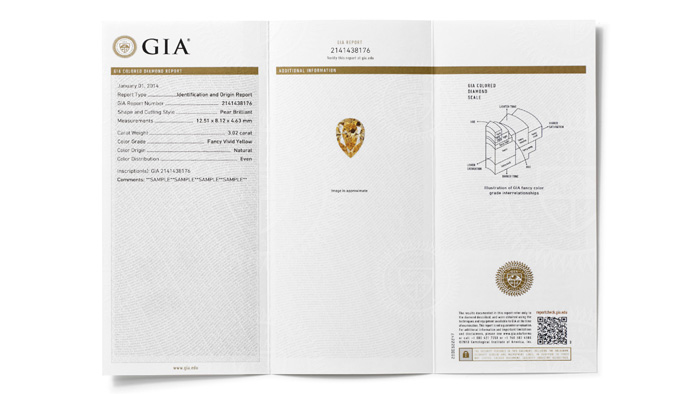Colored Diamond Grading
While the vast majority of diamonds fall in the D-to-Z color range, nature occasionally produces diamonds with a naturally occurring blue, brown, pink, deep yellow or even green hue. The geological conditions required to yield these colors are rare, making diamonds with distinct and naturally occurring shades scarce and highly prized.
Unlike colorless and near-colorless diamonds, fancy-color diamonds are evaluated less for brilliance or fire and more for color intensity. Shades that are deep and distinct are rated higher than weak or pale shades.
GIA describes color in terms of hue, tone and saturation. Hue refers to the diamond’s characteristic color, tone refers to the color’s relative lightness or darkness and saturation refers the color’s depth or strength. Using highly controlled viewing conditions and color comparators, a fancy color grader selects one of 27 hues, then describes tone and saturation with terms such as “Fancy Light,” “Fancy Intense,” and “Fancy Vivid.” The color system GIA developed is used worldwide.
GIA offers three types of grading reports for colored diamonds. The GIA Colored Diamond Grading Report contains the same comprehensive diamond 4Cs information as the GIA Diamond Grading Report, while the GIA Colored Diamond Origin Report adds to the grading data by providing a scientific determination of the diamond’s country of origin.
The third report type, the GIA Colored Diamond Identification and Origin Report (also known as the color-only report) is limited to color grade and the origin of the color (natural or treated).
GIA Colored Diamond Grading Report

The GIA Colored Diamond Grading Report provides a full quality assessment of a colored diamond including the color grade and color origin, carat weight, and clarity along with a plotted diagram of its clarity characteristics.
The GIA Colored Diamond Grading Report provides a full quality assessment of a colored diamond including the colored diamond color grade, color origin (natural or treated), carat weight, clarity, and a plotted diagram of its clarity characteristics. As an optional service, a full-color image of the diamond may also be included.
Unlike GIA’s D-to-Z color grading system, which is based on the relative absence of color, colored diamond color grading is based on the presence of color. Using a controlled viewing and lighting environment and a comprehensive set of color comparators, trained graders consistently determine the characteristic color of a diamond and assign a color grade (“pink,” for example). The hue chosen is modified by a “Fancy-grade” term, such as Fancy Light, Fancy, Fancy Intense, Fancy Deep, Fancy Vivid or Fancy Dark, which describes the combined effect of tone and saturation.
The laboratory issues this report on loose, natural colored diamonds weighing 0.15 carats or more. The GIA Colored Diamond Grading Report is not issued for laboratory-grown diamonds, simulants, mounted diamonds or those that have undergone unstable treatments, such as fracture-filling or coating. Any evidence of other treatment is prominently disclosed in the report.
New! GIA Colored Diamond Origin Report
The new GIA Colored Diamond Origin Report offers the full quality assessment of the Colored Diamond Grading Report, plus GIA’s scientific determination of the diamond’s country of origin. Image-rich, interactive materials accompany the report, describing the diamond’s home country and depicting the diamond’s journey from its rough to polished state. As an additional identifying feature, GIA laser inscribes the diamond’s unique report number on the stone’s girdle. Explore the GIA Diamond Origin Report.
GIA Colored Diamond Identification and Origin Report

The GIA Colored Diamond Identification and Origin Report describes a colored diamond’s color grade and its origin of color.
The GIA Colored Diamond Identification and Origin Report describes the color grade of a colored diamond as well as its origin of color (natural or treated). As an optional service, a full-color image of the diamond may also be included.
Both mounted and loose natural colored diamonds of any size can be submitted for this report service. The GIA Colored Diamond Identification and Origin Report is not issued for laboratory-grown, simulants, or diamonds that have undergone unstable treatments, such as fracture-filled or coated diamonds. Any evidence of other treatment is prominently disclosed in the report.




